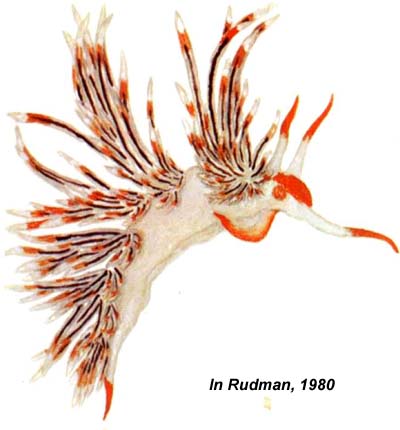This species has been observed on Madagascar Island
Species characteristics : Transparent white with an orange triangular patch on the head The basal third of both the rhinophores and the oral tentacles is translucent, the upper two thirds being bright orange. The lower two-thirds of each cerata is transparent. There is then a broad band of bright orange and then a region of white patching. The tip is transparent. The. digestive gland, which runs to halfway up the orange band is clearly visible and ranges in colour from light greenish brown to a dark chocolate brown. |

|
|
| Showing species characteristics... | Photo Alain-Benoît Rassat |
|
|
Remarks :
Bibliographic data :
|
 |
Animal large, up to 40 mm long, the most distinctive feature being the extremely long cerata, approximately two-thirds the body length
The oral tentacles are long and tapering.
The rhinophores are about two-thirds the length of the oral tentacles and in some specimens there are indistinct wrinkling and bumps
The cerata are usually extremely long, and often held upright
It feeds on hydroids. In Tanzania it was found feeding on both Salacia tetracythara and Eudendrium sp. cf. carneum
Etymology : The species name is derived from the Swahili name for the porcupine, nungunungu. This is an allusion to the behaviour of the animal, in erecting or bristling its cerata when startled
References :
Bill Rudman Seaslug site : Sea Slug Forum : Sakuraeolis nungunoides
Nudipixel Sakuraeolis nungunoides
Slug Site Sakuraeolis nungunoides
Publications :
Rudman, W.B. (1980). Aeolid opisthobranch molluscs (Glaucidae) from the Indian Ocean and the south-west Pacific. Zoological Journal of the Linnean Society, 68 : 139-172.
Other photos of Sakuraeolis nungunoides :
Alain-Benoît rassat Madagascar, Nosy Bé, 8 m, 11 May 2017, size : 20 mm |
With hight resolution... |
 |
|
More photos from Indian Ocean
If you have taken a photo of this species in South West Indian Ocean, please Contact us...